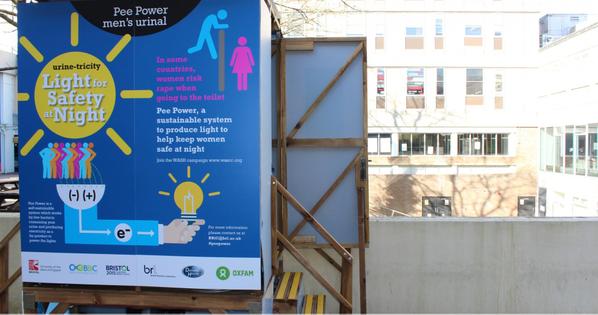
(https://twitter.com/UWEBristol/status/573572625995206656)
Last month, a small group from the IWSN Urban Water Security research group and Emerita Professor Clara Greed, an expert on public sanitation, visited one of our UWE colleagues, Professor Ioannis Ieropoulos and his team in the Bristol BioEnergy Centre, who are world leaders in microbial fuel cells (MFCs) working within the Bristol Robotics Laboratory, a collaboration between UWE’s Faculty of Environment and Technology and Bristol University. Originally developed to power small robotic devices, the MFCs use bacteria to generate electricity from waste fluids, the principle one of which is human urine. A test urinal has now been set up, with support from Oxfam on the UWE Frenchay campus, near the Students’ Union bar, which should guarantee plenty of fuel! The intention is to install similar units in refugee camps, hence Oxfam’s interest. These will produce electric light and reduce the danger, especially to women and children, of using the cubicles at night.
The technology is of great interest to IWSN as a key research question is how do poor communities in the Global South finance improved water and sanitation? This is a key feature in a neo-liberal world where responsibility for an increasing range of services is being decentralised down to a more local level and where market-based solutions to the supply of such services are increasingly being considered.
In the process of creating electricity, the by-products of the technology are clean water and fertilizers. Therefore, in theory, this green sanitation process has the potential to recycle and produce clean water, but also enables the owner of the cubicle to earn an income from the sale of the fertilizer, or to use it on their own land, thereby improving crop yield, food security or increased sales of surplus crops. This then opens up the possibility of individuals, or more likely communities, being able to borrow money from micro-financers to enable installation on the understanding that the technology provides additional earning power. Where there’s muck there’s brass!
The installations at UWE and those to be installed by Oxfam in refugee camps are important steps in gaining experience of the technology. By working with our NGO WASH partners in east Africa IWSN is keen to provide further opportunities for pilot studies amongst impoverished communities. They will provide a different and possibly more challenging environment in which to test the technology, because unlike the UWE site and refugee camps, there is unlikely to be local technological backup.
Some key factors that have to be considered when scaling up to meet these challenges include cost, robustness in use, the ability of users to undertake simple maintenance, whether it is culturally and gender appropriate and how the technology performs effectively in a range of tropical and semi-tropical environments. Given our practical, as well as research-based interest in this topic, IWSN is keen to provide further opportunities to evaluate this exciting technological advance in WASH provision.
One factor that is of critical importance is whether it is better suited to being installed for individual or communal use. Given the cost of approximately £600 per unit, this would put it outside the realm of impoverished families. However, collective payment and use is a possibility and has been championed as a means for improving WASH facilities in impoverished Global South communities, although not for this technology (Mara and Alabaster, 2008). If the technology is paid for by a group, then further issues arise as such communal resources inevitably complicate the relationship between user/owner and the communal technology. Issues around cleaning rotas, access to the electricity produced, or the income earned from it or the by-products would also need to be taken into consideration.
However, the main factor that might make or break the technology in terms of its attractiveness to potential micro-finance investors is whether it is financially viable, that is, will the income earned be sufficient to repay interest and eventually the initial principal borrowed? However, given the wider social benefits that this technology could produce, such as improved health, improved education, especially for women and girls due to reductions in time spent fetching water, and improvements in food security, if the technology works and is adopted by communities, there would be a case for some form of long-term subsidy that reflects these wider benefits.
[Reference: Mara, D., and Alabaster, G. (2008) A new paradigm for low-cost urban water supplies and sanitation in developing countries, Water Policy (10) 119–129]
